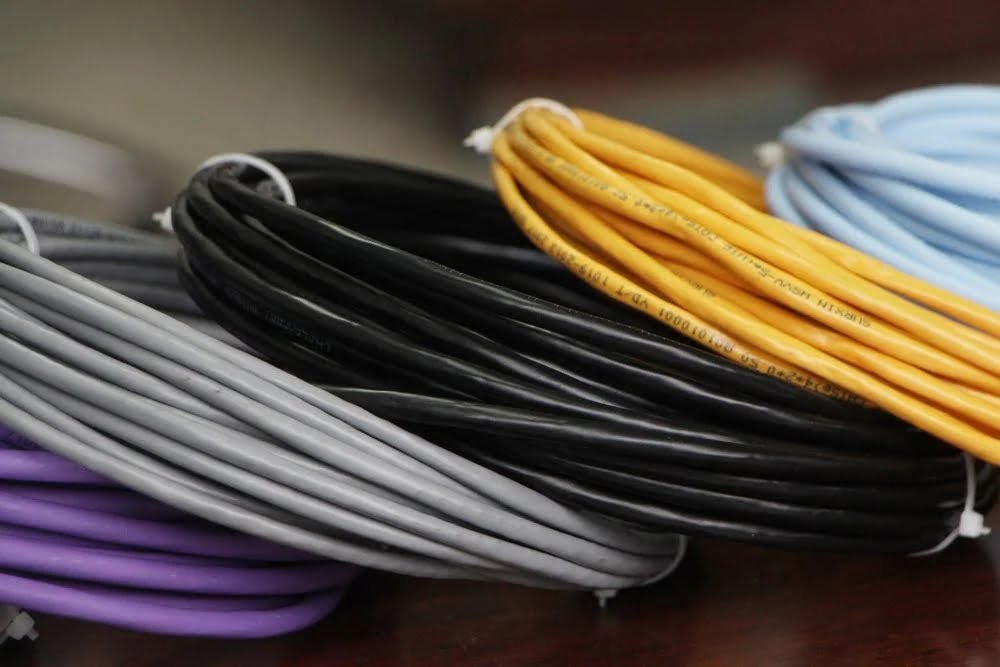Introductio ad UTP Cat6 Cable Vestibulum in Sinis
Patrui retorta Pair (UTP) Funes cat6 partes integrales sunt in substructionibus network modernis, praesertim propter facultatem ad support summus celeritas notitia tradenda. Hae rudentes variis applicationibus inserviunt, inter officium retiacula, Mauris interdum, et hospites amet broadband. Consilium robustum retinacula UTP Cat6 efficaciter reducit crosstalk et impedimentum, certo signo tradendo in spatia usque ad 100 metris non requirit addito amplificatione.
Sina emersit ut primarius fabricae funalium UTP Cat6, attracting global attentio aliquot de causis. Una ex praestantissimis commoda e funibus transmigrationis UTP Cat6 a Chinese instructus est auctor cursus sapien. Oeconomiae scalae effectae artifices Sinenses sinunt ut solutiones sumptus efficaces offerant sine ullo discrimine qualitatis.. Haec praestabilitas magnum commodum extendit in inceptis spectantibus ad aedificandum vel dilatandum substructiones retis eorum intra strictas rationes budgetary.
Progressiones technologicae in regione Sinarum fabricandi munus cruciale etiam exercent. Multi artifices Sinenses graviter collocant in statu-of-arte productionis facilitatum et armorum, ut eorum UTP Cat6 retinacula ad summa signa perficiendi et fidem. Facultates productionis scala in Sinis amplius auget facultatem ad magnas ordines prompte adimplendos, minima plumbi temporibus global customers.
Accedit, Intellectus signa et certificationes quae requiruntur ad retinacula UTP Cat6, essentialis est quando considerans transmigrationem ex Sinis. Hae rudentes signis internationalibus parere debent ut ANSI/TIA-568.2-D et ISO/IEC 11801, quae summatim speciem transmittendi notitia et cursus convenientiae in network systemata. Sinensis artifices saepe praebent comprehensivam probationem auditionum et certificationum ut adhaesionem suam hisce signis rigidis convalidant, offerens tranquillitatem animi emptoribus circa qualitatem et effectum eorum productorum.
Conclusio, compositum competitive cursus sapien, provectae technologiae, et facultates productionis robustae Sinas facit electionem cogens ad retinacula UTP Cat6. Negotiis pro negotiis quae tendebant aedificare substructiones certae et sumptus efficens retis, intelligendo fabricandis landscape in Sinis est vitalis.

Commune Quality et Packaging Exitus Congressi
Cum amet UTP Cat6 retinacula ab Lupum amet in Sinis, plures species et packaging inpedimenta possunt superficies, potentia afficiens altiore perficientur ac reliability rudentes. Una crebra cura est in observantia metrica repugnantia ut attenuatio et crosstalk. Attenuatio significat detrimentum virium insignem quod percurrit funem, dum crosstalk est impedimentum per signa circa fila. Variabilitas in his metricis signanter funem officiatis minuere potest et eam inhabilem reddere ad celeritatem data tradenda..
Alius communis exitus circa vitia corporis versatur. Laedi connexiones et pauperes Nulla problemata efficiunt. Exempli gratia, connexiones potest venire bent, Fracti, aut improprie crimped, ducit ad instabiles hospites. similiter, insufficiens Nulla potest exponere funes externis impedimentis, reducendo efficaciam et rest. Haec defectus non solum effectus attingunt, sed etiam signa salutis componunt, faciens rudentes massa arbitrium in discrimine applications.
Packaging relatas quaestiones etiam significantes. Satis tutela mensuras in naviculas consequuntur in funem venissent ad destinationem laesa. Exempli gratia, retinacula plexu modo causans flexionis kinks, aut referta non satis cushioning, ducens ad impulsum damnum. Recta est alia quaestio labeling; mislabeled packages potest causare confusionem et moras, praesertim si non occurrit regulatory vel elit Utilia requisitis.
Real-mundi testimonia underscore huiusmodi challenges. A UK-fundatur networking turba nuntiata accepto batch de UTP Cat6 funibus cum multis defectibus corporis, inter quassatas connexiones et inefficax velit, quae ad multa tempora et damna pecuniaria emendandas quaestiones perduxerunt. similiter, alius IT servitium provisor participatur experientias rudentes venientes cum insufficiens packaging, ex parte insignis ordinis inutile partus.
Has qualitates et packaging quaestiones compellans exactorem exactorem postulat, robust qualis imperium protocols, et manifesta communicationis vias inter ementes et praebitores. Agnoscendo et minuendo huiusmodi provocationes, Consociationes certiores et efficaces eventus consequi possunt in suis networkings inceptis.
Efficax Responsio et Resolutio Mechanismi
Reputabiles Sinenses praebitores luporum UTP Cat6 funes cum severitate responsionis et solutionis mechanismi adhaerent ad querelas electronicas pertinentes ad qualitatem vel packaging. Processus typice incipit apud hospicium quereretur ab emptore. Hoc generaliter fieri potest per plures vias communicationis, ut inscriptio, dedicated ministros portas, sive directam communicationem cum ratione managers.
Qua reclamationem, instructus aim providere initiali responsionem intus 24 to 48 horae. Haec responsio initialis saepe includit agnitionem litis ac aestimationem praeliminarem ad naturam et ambitum quaestionis determinare.. Per hoc scaena, supplementum petere informationis, ut photos vel felis, ut facilitate comprehensive iudicium.
Post-taxationem, et instructus procedere ad propositum consilium formandam in propria querimonia. Communia solutionis machinationes includunt fiebant reponenda batches funes UTP Cat6 ad emendandos quoscunque defectus., offering refunds pro defectu products, seu subsidia technica ad propositum institutionem seu usus quaestiones. Ita ut emptores minimam distractionem in operationibus suis experiantur.
Tertia pars qualitatis inspectiones funguntur munere funguntur in signis altis servandis et fidem augendo. Multi commeatus qualitatem independentem obtinent certitudinem firmorum ad inspectiones periodicas gerendas et certificant constantiam oblationum producti eorum.. Hic accessus proactive mitigat eventum querellarum qualitatis relatarum ac fiduciam fovet inter emptores internationales.
Customer servitium excellentia praecipua est pro victualibus Sinensium in mercatu competitive e UTP cablerum. maintaining communicationis transparent, opportune consilia offering, et exsequendam feedback agitatae melioramentis crucial exercitia quae underpin suum commitment ut mos satisfactio. Per has machinationes, praebitus non solum quaestiones resolvere efficaciter, sed etiam famam fidei et qualitatis in foro globali confirmare.
Suasiones pro emptoribus curare qualitatem et signa Packaging
Cum transcurrens UTP Cat6 retinacula ex Sinis, ens quale et proprium packaging signa precipua. Electus amet amet est essentialis primi gradus. Emptores debent prioritizare praebitores qui certificationes agnitae possident et signis internationalibus adhaerent. Haec accreditatio saepe verificari potest per directoria vel industriam consociationum quae in indice societatum certificati sunt. Conmisso cum certificatis instructus signanter reducit periculum qualitatis discrepantias.
Praeter eligens adprobatum amet, faciendi pre-amet inspectiones est critica usu. Hae inspectiones emptores permittunt ut cognoscerent qualitates et signa impedimentorum ordinum antequam conscenderent. Hiring tertia-pars inspectionis officia praebere potest pensationem producti, ut occurrat determinatis necessitatibus ". Hic gradus maxime pendet cum magnis ordinibus agitur, quia potentiale quaestiones mane adjuvat identify, vitando pretiosas controversias et dilationes.
Intellegere technicas specificationes et certificationes quae in tuto collocantur, alia ratio vitalis est. Consuescere te cum signis et certificationibus pertinentibus ut ISO, Rohs, and TIA/EIA-568-B.2-1, quae significant obsequium quale et salus guidelines. Plane haec requisita communica cum tuo supplemento et verificando quod producta haec signa conveniant vel excedant.
Efficax communicatio cum instructus facit narum prospere rem. Clarae leges et exspectationes de productum specificationibus constitue, packaging, et partus timelines. Prudenter consentire est in verbis ut controversiae resolutiones ad quasvis quaestiones efficientes tractandas accedant. Haec verba constituendi upfront adiuvat in quaestionibus quaelibet cito appellando, lenis res cursus.
Denique, leveraging feedback ex prior buyers potest providere valuable indagari. Recensiones et testimonia saepe elucidant exempla constantissima circa elit fidem et qualitatem productam. Adhibendis suggestis quae offerunt verificatur emptor videre potest adiuvare ad informationem faciendam.
Adhaerendo his commendationibus, buyers potest signanter augere casus recipiendi GENEROSUS UTP Cat6 cables, packaged in specificationibus, et efficaciter alloqui aliquas quaestiones, quae in procuratione processus emerserint.

